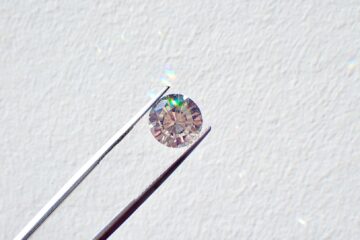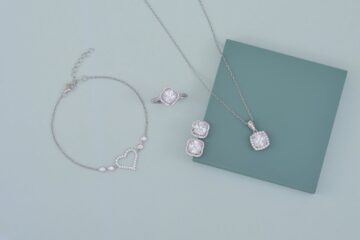Emerald-cut Rare Carat diamonds are rectangular or square gemstones with step-cut facets and truncated corners. They are known for their elegant geometry and ‘hall of mirrors’ effect, instead of having intense brilliance. The focus of this cut is on clarity and purity, which makes any imperfections easily noticeable. Visit Rare Carat for more about the emerald-cut diamond engagement ring.
Emerald-cut diamonds have a lower cost per carat than the round brilliant cuts, but their step-cut facets highlight clarity and color more prominently. Although the shape is cheaper to produce a higher grade, it is often necessary to achieve a visually clean, elegant stone which has an impact on the final emerald price.
Characteristics
Large, open table: The unobstructed view of the stone’s center is highlighted by the broad flat surface on top of the diamond, which provides an unobstructed view.
Step-cut facets: The facets are long, straight and rectangular, and run parallel to the diamond’s girdle, resembling steps on a staircase.
Hall of mirrors effect: A prismatic elegant effect is achieved by the parallel facets that reflect flashes of white, and dark light instead of a fiery sparkle.
Cut corners: The beveling of the four corners of the diamond enhances its durability, and prevents chipping.
Elongated shape: The standard emerald cut is rectangular, with a length-to-width ratio usually in the range of 1.30 and 1.50. Square emerald cut’s can also be obtained.
Pros and Cons
Pros:
Unique elegance: The hall of mirrors effect produces a sophisticated and understated glow that is distinct from the sparkle of brilliant-cut diamonds.
Looks larger: Emerald-cut diamonds often appear bigger than other cuts of the same carat weight due to their broad table and elongated shape.
Flattering on the hand: An elongated shape can produce the impression of longer more slender fingers.
Affordability: The round brilliant cut is generally more expensive per carat but this cut is typically less expensive because less rough diamond is wasted during the cutting process.
Cons:
Visible color: A higher color grade is commonly recommended because the broad facets can make the diamond’s body color more apparent.
Less sparkle: The purpose of the step-cut facets is to generate a subtle glint of light rather than the fiery brilliance of a round diamond.
Visible inclusions: A higher clarity grade is required to ensure that the diamond is ‘eye-clean’ due to the large, open facets leaving imperfections nowhere to hide.
Emerald-Cut Diamond Pricing Factors
The 4Cs (Cut, Clarity, Color, and Carat) can influence the price and value of an emerald-cut diamond, which are variations of each.
Cut Quality
Emerald cuts are valued for their ‘hall-of-mirrors’ effect, not their fiery sparkle, unlike brilliant cuts. The diamond’s symmetry and proportions are used to judge the quality of cut. A poorly cut stone may appear dull, or have dark, unattractive areas.
Proportions and symmetry: Excellent polish and symmetry are needed for achieving the desired light reflection in a high-quality emerald cut.
Beveled corners: The emerald cut is more durable due to the clipped corners that prevent the stone from chipping.
Length-to-width ratio: This ratio dictates the final appearance of the stone, from nearly square to long and dramatic.The most common ratios are between 1.30 and 1.50, with the ideal choice based on personal preference.
Color
The emerald cut’s open and step-cut nature makes it easier to see the diamond’s body color than brilliant-cut diamonds.
Lab-grown vs. natural: The 4Cs determine the price of both lab-grown and natural diamonds. For instance, a 1-carat emerald-cut lab-grown diamond could be significantly cheaper than a similar natural diamond.
White diamonds: Higher color grades (D-F) are the best option for a bright, white appearance, but they come with a higher cost. The best value for a stone that still appears white is found in near-colorless grades (G-J).
Clarity
The large, open table and flat, step-cut facets of an emerald cut make it easy to see inclusions and blemishes.
Recommended clarity grades: To ensure that the stone is clean, it is usually recommended to have a clarity grade of VS1, or VS2. Inclusion placement is crucial for an emerald cut, as those near the edges are less noticeable than those under the center table.
Higher clarity, higher price: Choosing a higher clarity grade (VVS1 or VVS2) is a secure choice, but it has a higher cost.
Carat Weight
Emerald-cuts are larger than other diamond shapes of the same carat weight due to their elongated shape. This significant advantage can be advantageous for buyers who want a more substantial look on their finger but can’t afford the higher per-carat price of a round cut.
Why are Emerald Cuts are Generally Less Expensive?
Higher yield from rough stone: An emerald cut preserves the rough diamond’s original carat weight more than a round brilliant cut. The round cut is achieved by removing the corners of the rough stone which results in a significant weight loss and a higher cost per carat.
Greater affordability: The higher yield is the main reason why emerald-cut diamonds usually cost less than round diamonds of the same carat weight and quality.




